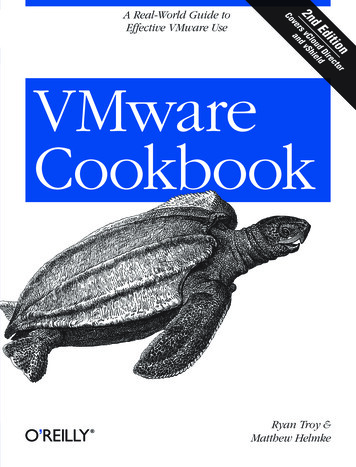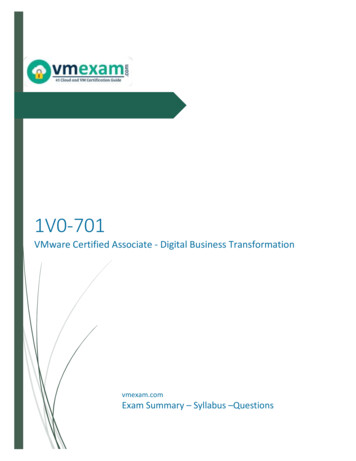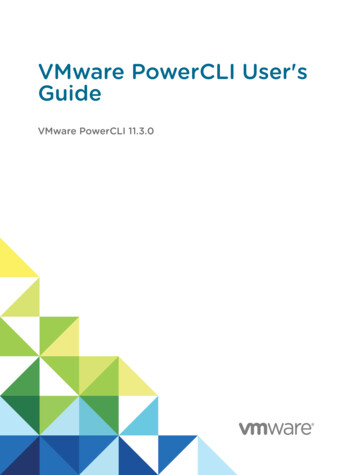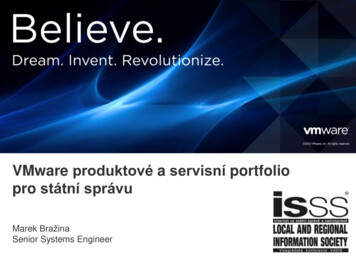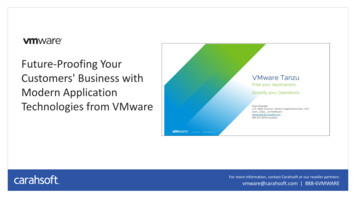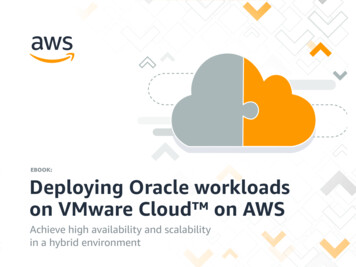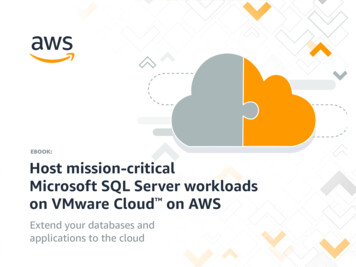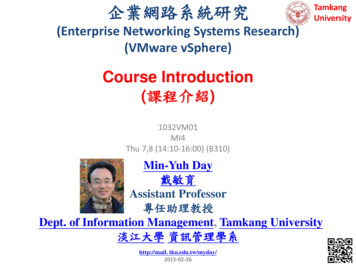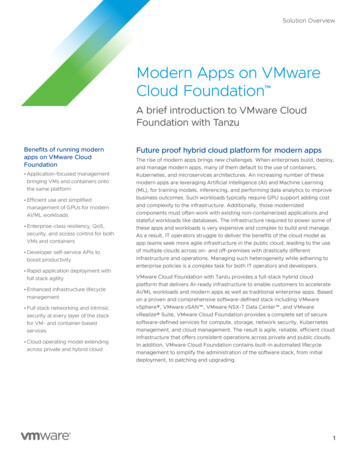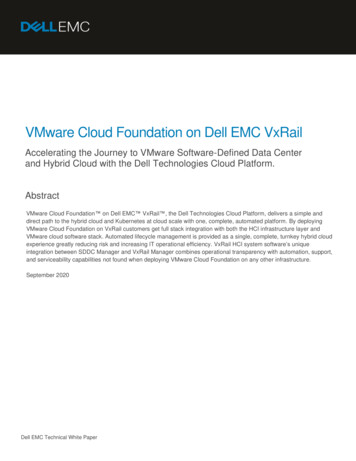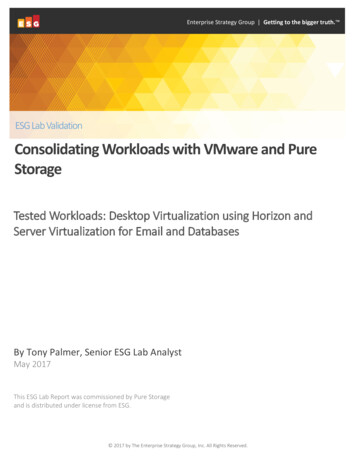
Transcription
Enterprise Strategy Group Getting to the bigger truth. ESG Lab ValidationConsolidating Workloads with VMware and PureStorageTested Workloads: Desktop Virtualization using Horizon andServer Virtualization for Email and DatabasesBy Tony Palmer, Senior ESG Lab AnalystMay 2017This ESG Lab Report was commissioned by Pure Storageand is distributed under license from ESG. 2017 by The Enterprise Strategy Group, Inc. All Rights Reserved.
Lab Validation: Consolidating Workloads with VMware and Pure Storage2ContentsIntroduction . 3Background . 3Pure Storage FlashArray//M . 4FlashArray Analytics with Pure1 . 6Cisco UCS and FlashArray: The FlashStack Infrastructure Solution . 7ESG Lab Validation . 7Getting Started. 8Consolidating Workloads . 10High Availability and Resilience . 15ESG Lab Testing . 15ESG Lab Validation Highlights . 19Issues to Consider . 19The Bigger Truth. 20Appendix . 21ESG Lab ReportsThe goal of ESG Lab reports is to educate IT professionals about data center technology products forcompanies of all types and sizes. ESG Lab reports are not meant to replace the evaluation process thatshould be conducted before making purchasing decisions, but rather to provide insight into these emergingtechnologies. Our objective is to go over some of the more valuable feature/functions of products, showhow they can be used to solve real customer problems and identify any areas needing improvement. ESGLab's expert third-party perspective is based on our own hands-on testing as well as on interviews withcustomers who use these products in production environments. 2017 by The Enterprise Strategy Group, Inc. All Rights Reserved.
Lab Validation: Consolidating Workloads with VMware and Pure Storage3IntroductionThis ESG Lab Validation report documents hands-on testing and validation of the Pure Storage FlashArray//M storagesystem. The goal of the report is to prove that tier-1 application workloads such as desktop virtualization, databases, andemail can be run on a shared, consolidated storage array without compromising service levels, while delivering consistentsub-millisecond response times. A 5,000-user enterprise was simulated to validate this premise, running on a single allflash storage array. In addition, failure scenarios were introduced to test resiliency.BackgroundThe adoption of server virtualization is pervasive among enterprise and midmarket organizations today, and increased useof the technology was identified by more than one-third (36%) of respondents as one of the five areas related to datacenter modernization in which they plan to make the most significant investments in 2017 (see Figure 1). The dataadditionally revealed that increasing the use of solid-state/flash technology was also one of the top five areas for datacenter modernization spending reported by respondent organizations.1Figure 1. 2017 Data Center Modernization Spending PrioritiesWe would like to learn more about your specific spending plans for data center modernization.In which of the following areas will your organization make the most significant investmentsover the next 12-18 months? (Percent of respondents, N 339, five responses accepted)Increasing use of server virtualization36%Improving data backup and recovery32%IT infrastructure orchestration/automation tools32%Data center consolidation28%Increasing use of solid-state/flash storage technology27%Deploying converged infrastructure platform26%Implementing a “software-defined data center”strategy26%Building a “private cloud” infrastructure25%Deploying hyperconverged infrastructure24%Increasing use open source platform softwareDon't know/too soon to tell20%4%Source: Enterprise Strategy Group, 2017In ESG Lab’s experience, desktop and application virtualization are responsible for some of the most complex anddemanding storage workloads in the data center. Organizations are tasked with providing a high-quality, predictable, andproductive computing environment for an ever-growing number and range of virtual desktop users. For organizations thathave deployed or are considering deploying desktop virtualization, performance is one of the most important metrics toconsider in gauging the success of their deployments.1Source ESG Research Report: 2017 IT Spending Intentions Survey, March 2017. 2017 by The Enterprise Strategy Group, Inc. All Rights Reserved.
Lab Validation: Consolidating Workloads with VMware and Pure Storage4In addition, enterprise application environments have become increasingly unpredictable as their underlying ITinfrastructure grows in complexity, size, and criticality to the business. Mission-critical business application performance ishighly sensitive to storage performance and latency, and highly dependent on the resilience of the enterprise ITenvironment. ESG confirmed in a recent research report that flash-based systems have become prevalent in theseenvironments due to their ability to provide extremely high performance at very low response times.It’s not surprising that many organizations deploying desktop virtualization are doing so with dedicated storage systemsseparate from the rest of their infrastructure. A number of factors drive IT’s need to maximize the value of their flashbased storage, including the wide variety and number of client devices; “always-on” expectations for IT services; workforcemobilization; regulatory compliance mandates; tightening security requirements; and corporate demands.Pure Storage FlashArray//MWith the advent of software-defined storage, questions have been raised about the value of custom hardware—inparticular, whether storage hardware should be considered a commodity that leverages software exclusively for innovationand development. With the FlashArray//M architecture, Pure Storage has responded, and their answer is a clear “NO.”FlashArray//M is NVMe-ready all-flash storage engineered to combine the speed, simplicity, and scalability needed toenable organizations to power their applications, either on-premises or in the cloud. Pure describes FlashArray//M aseffortless, efficient, and evergreen. Effortless—The FlashArray//M is designed to be highly available, leveraging innovative approaches to both hardwareand software. In previous testing ESG Lab observed uninterrupted access and full performance through plannedupgrade and unplanned outage scenarios. Pure Storage employs array telemetry to predict issues before they impactcustomers. In conjunction with Pure1, a SaaS-based platform, customers can monitor storage from anywhere andwith any device. Efficient—Pure Storage has designed the FlashArray//M to achieve an average 5:1 data reduction ratio across mixeddata types and workloads to facilitate consolidation. Integration with partners enables automation of repetitive tasks. Evergreen—Pure employs a modular architecture to ease customer deployment of the array and enables data-in-place upgrades of performance and capacity over the life of the storage in the customer environment whileminimizing downtime, performance impact, and data migrations.Pure provides all software features in FlashArray and Pure1 to customers at no additional cost.Figure 2. Storage Consolidation with Pure Storage FlashArray//MSource: Enterprise Strategy Group, 2017 2017 by The Enterprise Strategy Group, Inc. All Rights Reserved.
Lab Validation: Consolidating Workloads with VMware and Pure Storage5It’s important to note that the performance numbers Pure reports for their arrays are for 32KB IOPS. Many vendorscommonly report 4KB IOPS results because systems can service higher numbers of smaller I/O requests. ESG Lab hasobserved that real-world environments are dominated by I/O that averages around 32 KB. FlashArray//M is designed toadapt automatically to any I/O block size to provide optimal performance, scalability, and data reduction withoutapplication tuning.Figure 3. Pure Storage FlashArray//MSource: Enterprise Strategy Group, 2017Pure Storage considers its data reduction technology, FlashReduce, to be a significant differentiator. FlashReduceautomatically deduplicates and compresses live data as it is written to the array. Pure claims an average reduction ratio of5:1, or 80%, but this varies across different types of applications. Figure 4 shows an example of what this would look like ina production environment. It’s important to note that the numbers included here do not include thin provisioning savings;Pure Storage volumes are automatically thin provisioned, which would add to the savings.Figure 4. Pure Storage FlashArray//M Data ReductionSource: Enterprise Strategy Group, 2017 2017 by The Enterprise Strategy Group, Inc. All Rights Reserved.
Lab Validation: Consolidating Workloads with VMware and Pure Storage6Often, the perception of commodity hardware is associated, correctly or incorrectly, with lower storage costs. Ultimately,however, the goal should be to provide value to the customer. The values that Pure aims to provide are ambitious,including but not limited to: Simplicity — The modular design provides online data-in-place upgrades of hardware and software along with thesupport of capacity expansion shelves. All software features, including HA, DR, snapshots, and management, areincluded at no additional cost. Manageability — Pure1 provides integrated management and support in a single cloud-based platform, real-timestorage analysis with proactive alerting, and monitoring from anywhere with no management installation ormaintenance required. Density — Pure provides support for up to 250 TB usable capacity in a 3U chassis, and 1.5 PB in an 11U chassis. Longevity — The solution leverages the modularity of the FlashArray//M for greater generational upgrade flexibility.Controller upgrades every three years are included in maintenance, as are all software updates. Power efficiency — Pure is quite energy-efficient; 250 TB of usable capacity consumes less than 1kW. Resilience – Pure uses a redundant, hot-swappable hardware design with stateless controllers and distributed datamirroring across non-volatile RAM. Data is protected from failure modes specific to flash with a dual parity systemcalled RAID-3D.Consolidation drives economic savings in the data center, and Pure enables this with its data reduction technology.FlashArray Analytics with Pure1In addition to cloud-based management, Pure Storage offers proactive support via Pure1 Global Insight. Pure1 usescollected telemetry data to identify issues proactively before the customer detects them, employing predictive analyticsand machine learning. Logs are collected from customers’ arrays every 30 seconds. Global Insight compares those logsagainst Pure’s issue fingerprint library to identify what needs to be resolved and notifies Pure’s internal support team.Beyond detecting storage issues, Global Insight is also designed to detect issues if storage is not the cause—issues withnetwork connections, for example—Figure 5 details the capabilities included in Pure1. 2017 by The Enterprise Strategy Group, Inc. All Rights Reserved.
Lab Validation: Consolidating Workloads with VMware and Pure Storage7Figure 5. Pure1 Cloud-based Reporting and AnalyticsSource: Enterprise Strategy Group, 2017Pure also offers both performance and capacity analytics in Pure1. The performance analytics feature allows customers togain more detailed visibility into an array’s performance, such as latency, IOPS, and bandwidth. Performance can beexamined more closely at the array or volume level. A customer can also forecast storage consumption via the capacityanalytics feature. Using different built-in consumption models (e.g., linear or mirror), the generated forecast allows forbetter capacity planning for the customer.Cisco UCS and FlashArray: The FlashStack Infrastructure SolutionThis ESG Lab Validation, while focused primarily on exercising and demonstrating the resilience of the FlashArray system inhighly consolidated environments, was performed on a unified architecture consisting of compute, fabric, and storagecalled FlashStack. The FlashStack architecture is pre-tested, pre-validated, and thoroughly documented by Cisco and PureStorage. The FlashStack platform is designed for consolidated workloads, and can also serve as a highly available platformfor private cloud. Organizations use converged infrastructures like FlashStack to streamline operations, increase flexibilityand efficiency, and deliver business impact.Like FlashArray, FlashStack is designed to scale without disruption or changes in management or operational models.Organizations with FlashStack architectures or that are interested in obtaining more information about FlashStack can usethe findings in this ESG Lab Validation report to educate themselves on the capabilities of FlashStack in the context of datacenter availability and resilience.ESG Lab ValidationThis ESG Lab Validation report documents hands-on testing and validation of the Pure Storage FlashArray//M storagesystem in a FlashStack architecture with Cisco UCS and Nexus fabric. ESG Lab performed hands-on evaluation and testingof Pure Storage FlashArray//M with VMware at Pure Storage facilities in Mountain View, California. Testing was designedto validate the consolidation potential offered by a single FlashArray//M storage system with a focus on delivering highlevels of predictable performance for multiple, simultaneously running, tier-1 application workloads. The ability to sustainthese high-performance levels through various storage hardware failures was also tested. 2017 by The Enterprise Strategy Group, Inc. All Rights Reserved.
Lab Validation: Consolidating Workloads with VMware and Pure Storage8Getting StartedESG Lab began with a pre-wired and pre-configured test bed as summarized in Figure 6. A VMware vSphere 6.0 virtualizedinfrastructure was deployed on 32 Cisco UCS B2000 M4 blade servers, each leveraging a 12-core, 2.3 GHz processor with256 GB of RAM. Service profiles for all servers were created using a service profile template with vNIC and vHBA templates,and the VMware adapter policy was selected for both. Boot-from-SAN functionality was configured by utilizing the privatevolume feature of the Pure FlashArray software.The servers were connected to redundant Cisco UCS 6248UP fabric interconnects via 10Gb Ethernet with the last eightports of each interconnect configured as Fibre Channel (FC) ports. The interconnects were configured in End Host Modefor both FC and Ethernet, and were connected to redundant Nexus 5500UP storage and network switches, which werealso configured to support both FC and Ethernet. The switches were then connected via two pairs of 8GB FC cables to aPure Store FlashArray//M50 running Purity 4.5.1 software with two drive packs.The servers, fabric, and storage were connected in a manner consistent with the FlashStack architecture as defined in theCisco Validated Design FlashStack Virtual Server Infrastructure for VMware vSphere available on the Cisco website.2Figure 6. ESG Lab FlashStack Test Bed Simulating a 5,000-user EnterpriseSource: Enterprise Strategy Group, 2017Five common, mission-critical applications were deployed within the VMware virtualized infrastructure, including a VDIenvironment, three unique database environments, and an email environment. The VDI environment was managed andcontrolled by VMware Horizon 6, the virtual desktop host platform for VMware vSphere. Fifteen-hundred non-persistent,linked-clone virtual desktops were created from a Horizon desktop image template, which leveraged a 32GB base image.Each desktop was configured with Windows 7 Enterprise edition (64-bit) and utilized two vCPUs, 4 GB of RAM, onevmxnet3 vNIC adapter, and one LSI Logic virtual storage adapter. Installed applications included Microsoft Office 2010,Adobe Reader 11, Flash Player Active X, Doro 182, Internet Explorer, Archive-7Zip, and Windows Media Player.3Two Microsoft SQL Server 2014 Enterprise Edition instances were created, one as an OLTP database and the other as adata warehouse for decision support. The OLTP database instance ran in a VM with 128 GB of RAM, ten vCPUs, and fourvSockets. A 300,000-user database was spread across a file group consisting of nine files and totaled 3.2 TBs. The datawarehouse database consisted of a primary data file that totaled 656 GB with a log file of 297 GB.FlashStack Virtual Server Infrastructure for VMware vSphere. More details on FlashStack and the FlashStack architecture can be found atwww.cisco.com/go/flashstack.3 Additional information about the test bed can be found in the Appendix.2 2017 by The Enterprise Strategy Group, Inc. All Rights Reserved.
Lab Validation: Consolidating Workloads with VMware and Pure Storage9For email, testing leveraged a Microsoft Exchange Server 2013 environment that consisted of 5,000 mailboxes with a sizeof 1 GB each. The email database was configured with 4.91 TB and a log file that was set to truncate. Lastly, a 1 TB OracleOLTP database was configured to support up to 128 concurrent users.ESG Lab leveraged both the VMware vCenter and Pure Storage web management interfaces to manage and monitor thedeployed applications. Figure 7 shows the five running virtualized applications in VMware vCenter, while the Pure Storagedashboard shows alerts, real-time performance metrics, and capacity information for those applications. It’s important tonote that the Pure Storage Dashboard is available as both a native web GUI and as a vSphere web client plug-in. In thisreport, all Pure Storage screenshots are taken from the native GUI.Figure 7. Test Bed Monitoring from VMware vCenter and Pure Storage Web Management InterfaceSource: Enterprise Strategy Group, 2017Once the workloads were up and running, ESG Lab also tested the resiliency of the solution by simulating variouscomponent failures with a goal of understanding the minimal performance impact on the collective workloads.Why This MattersIn a dynamic IT environment, the ability to quickly provision and manage data services is crucial for enabling ITadministrators to meet the demands of the business. As IT is being asked to do more with less, they need flexible, easy-touse tools that enable efficient provisioning and management with minimal effort. This is especially true in virtual serverenvironments, where application consolidation can help improve resource utilization while meeting strict budgetrequirements.By leveraging a Pure Storage FlashArray//M as the underlying storage system, organizations gain peace of mind that all oftheir most demanding tier-1 virtualized applications can run simultaneously and still meet their performance andavailability SLAs. Organizations gain the benefit of centralized storage management via the VMware vCenter managementinterface and vRealize private cloud suite of products with built-in Pure Storage integration. 2017 by The Enterprise Strategy Group, Inc. All Rights Reserved.
Lab Validation: Consolidating Workloads with VMware and Pure Storage10Consolidating WorkloadsESG Lab leveraged the virtualized infrastructure to run performance tests on each of the five deployed applicationssimultaneously with a goal of showing how the Pure Storage FlashArray//M can easily satisfy the demanding performancerequirements of a consolidated, virtualized infrastructure. The test process consisted of starting one of the applicationworkloads, waiting for steady state, and then launching the next applications until all five were running simultaneously.Throughout the process, ESG Lab used the Pure Storage management interface to monitor the latency, IOPS, andthroughput of each application, as well as the cumulative performance metrics.The first workload was driven by Login VSI to emulate the activity of 1,500 Horizon virtual desktops. Login VSI is anindustry-standard virtual desktop infrastructure (VDI) benchmarking tool that validates application performance andresponse times for various predefined VDI workloads with an ultimate goal of showing the desktop density potential for agiven set of hardware and software components. This is done by mimicking typical user behavior in well-known desktopapplications like Microsoft Office, Internet Explorer, and Adobe Acrobat reader. For this phase of testing, a “heavy”workload was run to simulate the behavior of a typical “power user.”A log-on storm of the 1,500 virtual desktops was simulated, which represents a large number of end-users launching theirvirtual desktops at the same time. This can often lead to high response times and degradation of services due to theoverwhelming number of data requests. As shown in Figure 8, ESG Lab witnessed consistent, sub-millisecond latency as theworkload ramped up and eventually hit steady state.Figure 8. Horizon Workload Ramp-up and Steady StateSource: Enterprise Strategy Group, 2017Next, the Microsoft Exchange Jetstress 2013 workload was used to emulate the storage activity of typical email users.Jetstress simulates the Exchange database and log file loads produced by a specified number of users. Jetstress wasconfigured to emulate up to 5,000 mailboxes per VM with a mailbox size of 1 GB and an I/O rate of .5 IOPS per mailbox. 2017 by The Enterprise Strategy Group, Inc. All Rights Reserved.
Lab Validation: Consolidating Workloads with VMware and Pure Storage11Figure 9. Measuring Consolidated Workload PerformanceSource: Enterprise Strategy Group, 2017Next, the DSS workload was simulated using HammerDB, an industry-standard, open source database load testing andbenchmarking tool. The test was configured with a scale factor of 700, 150 virtual users, 100 iterations, and a MAXDOP ofeight. Once steady state was achieved, a proprietary Microsoft OLTP test tool was used to simulate the activity ofthousands of Microsoft SQL Server users. The workload itself emulated the database activity of users in a typical onlinebrokerage firm as they generated trades, performed account inquiries, and executed market research. The workload wascomposed of ten transaction types with a defined ratio of execution. Four of the transactions performed databaseupdates, and the rest were read only.For the last workload, an OLTP workload was run on an Oracle database. The widely adopted and publicly available SillyLittle Oracle Benchmark (SLOB) kit was used to efficiently generate realistic system-wide, random, single-block, andapplication-independent SQL queries. The SLOB benchmark tool exercised all components of the server and storagesubsystems by stressing the physical I/O layer of Oracle through SGA-buffered random I/O without being limited to aspecific load-generating application.Figure 9 shows the total IOPS of each of the five workloads as they ramped up and hit steady state. The time intervalsdemonstrate that over the course of an hour and a half, all five applications were launched and hit steady state. It shouldbe noted that latency was another performance metric that was measured and throughout the launching of eachapplication, latency remained manageably low, with response times remaining under 1ms in all cases. 2017 by The Enterprise Strategy Group, Inc. All Rights Reserved.
Lab Validation: Consolidating Workloads with VMware and Pure Storage12An important aspect of consolidating workloads is understanding the performance impact that each application could haveon the others when they’re running simultaneously. With that in mind, ESG Lab went back to the initial VDI workload andlooked at each performance metric over the course of the hour and a half. As each application workload started andeventually hit steady state, there was little to no performance impact to the initial VDI workload. This is crucial to deliveringa virtual desktop environment that can meet the demands of end-users who demand constant, uninterrupted access totheir essential desktop applications. Figure 10 shows the I/O latency of the Horizon workload as each application wasstarted, with callouts pointing to the time intervals where workloads were started.Figure 10. Measuring Consolidated Workload PerformanceSource: Enterprise Strategy Group, 2017Once all the workloads were running simultaneously, ESG Lab navigated back to the main dashboard view of the PureStorage management interface to view cumulative performance metrics. As shown in Figure 11, I/O latency of thesimultaneously running simulated applications remained manageably low, while IOPS and throughput remained stable andpredictable. The ability of the Pure Storage FlashArray//M to deliver consistent and predictable performance to all fiveapplication workloads simultaneously was impressive to ESG Lab. Each workload not only had different performancerequirements, but also put a different demand on the underlying storage platform, and the FlashArray//M was easily ableto support it. 2017 by The Enterprise Strategy Group, Inc. All Rights Reserved.
Lab Validation: Consolidating Workloads with VMware and Pure Storage13Figure 11. Cumulative Performance of Five Virtualized ApplicationsSource: Enterprise Strategy Group, 2017For email, testing leveraged a Microsoft Exchange Server 2013 environment that consisted of 5,000 mailboxes with a sizeof 1 GB each. The email database was configured with 4.91 TB and a log file that was set to truncate. Lastly, a 1 TB OracleOLTP database was configured to support up to 128 concurrent users.ESG Lab leveraged both the VMware vCenter and Pure Storage web management interfaces to manage and monitor thedeployed applications. Figure 6 shows the five running virtualized applications in VMware vCenter, while the Pure Storagedashboard shows alerts, real-time performance metrics, and capacity information for those applications. It’s important tonote that the Pure Storage Dashboard is available as both a native web GUI and as a vSphere web client plug-in. In thisreport, all Pure Storage screenshots are taken from the native GUI.The next phase of testing looked at the recomposition of all 1,500 virtual desktops on top of the other workloads. Therecompose process consists of attaching a linked-clone VDI environment to a new replica, which forces users into a brandnew virtual desktop environment. This is an intrusive operation that can cause existing users to lose connectivity to theirvirtual desktops. In ESG’s testing, the four other mission-critical applications were started and, once steady state wasachieved, the 1,500 virtual desktop boot-storm started. Once complete, the recompose operation was initiated.Figure 12 displays a view of the performance metrics after the other four workloads had reached a steady state. The virtualdesktop ramp-up time took approximately 50 minutes. Next, the recompose was started, which led to a brief, five-minuteinterval where the linked-clone replicas were created. During this period of time, a latency spike of approximately 2 msoccurred for less than one minute. The latency then returned to its normal sub-millisecond measurement throughout therest of the recompose process. 2017 by The Enterprise Strategy Group, Inc. All Rights Reserved.
Lab Validation: Consolidating Workloads with VMware and Pure Storage14Figure 12. Recomposing 1,500 Virtual Desktops in a Consolidated Virtualized EnvironmentSource: Enterprise Strategy Group, 2017Why This MattersLeveraging virtualization to consolidate workloads can help drive higher levels of infrastructure efficiency throughimproved resource utilization, but when multiple applications share the same underlying storage system, problems canquickly arise. A burst of I/O activity from one application (e.g., a long-running database query) can significantly impact allthe other applications, leading to poor response times, lost productivity, and, in the worst case, lost revenue.ESG Lab validated that five virtualized, mission-critical applications were easily consolidated onto a s
With the FlashArray//M architecture, Pure Storage has responded, and their answer is a clear "NO." FlashArray//M is NVMe-ready all-flash storage engineered to combine the speed, simplicity, and scalability needed to enable organizations to power their applications, either on-premises or in the cloud. Pure describes FlashArray//M as


